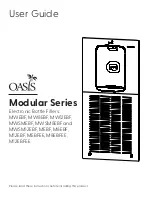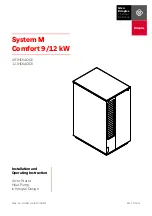
18
Goulds Pumps
PHV - Packaged Hydrovar Series
PERFORMANCE WITH VARYING SPEED FOR CENTRIFUGAL PUMPS
Fitting the electric pump with a variable speed drive makes it possible to vary the pump rotation speed, normally accor-
ding to the system pressure parameter.
Variations in electric pump speed
result in
modified performances
according to the equivalence relations, called affinity laws.
n1 = initial speed;
n2= speed required.
Q1 = initial flow rate;
Q2= flow rate required.
H1 = initial head;
H2= head required.
P1 = initial power;
P2= power required
Frequency ratios
can be used instead of speed in practical applications, keeping 30 Hz as the bottom limit.
Example :
2-pole 50 Hz electric pump n1 =2900 (point A)
Flow rate (A) = 100 l/min; Head (A) = 50m
By reducing the frequency to 30 Hz the speed is reduced to approx. n2 = 1740 rpm (point B)
Flow rate (B) = 60 l/min; Head (B) = 18 m
The power of the new work point B is cut to about 22% of the initial power.
SIZING THE DIAPHRAGM TANK IN SYSTEMS WITH SPEED VARIATION
Variable speed
booster sets need
smaller tanks
compared to traditional systems. Generally speaking, a tank with a
capacity of just 20% of the nominal capacity of a single pump, expressed in gallons per minute, is needed. The
gradual
starting
of the pumps controlled by the drive reduces the need to limit the number of hourly starts; the main purpose
of the tank is to compensate for small system losses, stabilize the pressure and make up for pressure variations caused by
sudden demand (fast acting valves).
Make the following calculation:
Set made up of three electric pumps, each with a maximum flow rate of 100 GPM, for a total capacity of 300 GPM. The
volume
required for the tank is 20 gallons. This is total capacity, not drawdown. Mount downstream of the check valves
in discharge manifold.
Flow Rate
Head
Power
Q1
=
n1
Q2
n2
H1
=
n1
H2
n2
2
P1
=
n1
P2
n2
3
Q1
Q2
Q
H1
H2
H
Flow
Head
n2
n1
A
B
Summary of Contents for BPHV
Page 50: ...50 Goulds Pumps PHV Packaged Hydrovar Series NOTES...
Page 51: ...51 NOTES...
















































